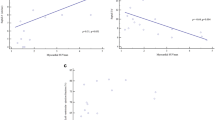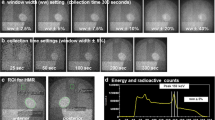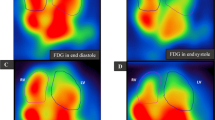Abstract
Objectives
123I-metaiodobenzylguanidine (MIBG) has been used to estimate cardiac sympathetic nervous innervation. Heterogeneous MIBG distribution is mainly associated with high physiological MIBG uptakes in the liver. We postulate that prone position acquisition might be especially effective for MIBG, providing for separation from high liver uptake similar to that provided by perfusion single-photon emission computed tomography (SPECT). We investigated whether prone-position acquisition improved MIBG image quality by comparing our results to those acquired using supine MIBG and high-quality 11C-hydroxyephedrine (HED) positron emission tomography/computed tomography PET/CT.
Methods
Ten male volunteers (body mass index (BMI) 22.7 ± 3.4) underwent prone and supine MIBG and HED PET. Relative regional tracer uptake was estimated in early MIBG and HED. Acquired images were divided into 17 segments and were grouped into 4 regions: anterior, inferior, septum, and lateral. For each patient, the inferior/anterior ratio was calculated.
Results
The quality of images acquired using prone MIBG was better than that using supine MIBG (p < 0.05). Inferior and septum relative MIBG uptake was reduced in comparison with anterior or lateral MIBG uptake in the supine position (inferior vs. anterior: 69.0 ± 5.6 vs. 82.3 ± 4.6 %, p < 0.01; septum vs. lateral: 66.2 ± 5.1 vs. 81.9 ± 5.4 %, p < 0.01). Prone MIBG showed a significantly higher inferior/anterior uptake ratio in comparison with supine MIBG (n = 24, seg: 92.2 ± 7.2 vs. 83.6 ± 5.7 %, p < 0.05). However, intergroup differences in uptake ratio were demonstrated among prone and supine MIBG and HED. HED PET/CT still showed a higher uptake ratio in comparison with prone MIBG SPECT (103.9 ± 8.0 vs. 92.2 ± 7.2 %, p < 0.05).
Conclusion
Even in normal male subjects, standard supine MIBG imaging showed reduced inferior and septum uptake. Uptake with prone MIBG imaging showed a significant improvement over that with supine imaging and was closer to uptake for HED PET/CT. This improvement may be the result of preventing intense uptake by the liver. Prone data acquisition may be a viable alternative in evaluating regional abnormalities using MIBG SPECT in men.



Similar content being viewed by others
References
Carrio I, Cowie MR, Yamazaki J, Udelson J, Camici PG. Cardiac sympathetic imaging with mIBG in heart failure. JACC Cardiovasc Imaging. 2010;3(1):92–100.
Travin MI. Cardiac autonomic imaging with SPECT tracers. J Nucl Cardiol. 2013;20(1):128–43 (quiz 46).
Yoshinaga K, Chow BJ, DeKemp RA, Thorn S, Ruddy TD, Davies RA, et al. Application of cardiac molecular imaging using positron emission tomography in evaluation of drug and therapeutics for cardiovascular disorders. Curr Pharm Des. 2005;11(7):903–32.
Zipes DP. Sympathetic stimulation and arrhythmias. N Engl J Med. 1991;325(9):656–7.
Nakajima K, Okuda K, Matsuo S, Yoshita M, Taki J, Yamada M, et al. Standardization of metaiodobenzylguanidine heart to mediastinum ratio using a calibration phantom: effects of correction on normal databases and a multicentre study. Eur J Nucl Med Mol Imaging. 2012;39(1):113–9.
Tamaki N, Yoshinaga K. Novel iodinated tracers, MIBG and BMIPP, for nuclear cardiology. J Nucl Cardiol. 2011;18(1):135–43.
Boogers MJ, Borleffs CJ, Henneman MM, van Bommel RJ, van Ramshorst J, Boersma E, et al. Cardiac sympathetic denervation assessed with 123-iodine metaiodobenzylguanidine imaging predicts ventricular arrhythmias in implantable cardioverter-defibrillator patients. J Am Coll Cardiol. 2010;55(24):2769–77.
Jacobson AF, Senior R, Cerqueira MD, Wong ND, Thomas GS, Lopez VA, et al. Myocardial iodine-123 meta-iodobenzylguanidine imaging and cardiac events in heart failure. Results of the prospective ADMIRE-HF (AdreView Myocardial Imaging for Risk Evaluation in Heart Failure) study. J Am Coll Cardiol. 2010;55(20):2212–21.
Nakata T, Miyamoto K, Doi A, Sasao H, Wakabayashi T, Kobayashi H, et al. Cardiac death prediction and impaired cardiac sympathetic innervation assessed by MIBG in patients with failing and nonfailing hearts. J Nucl Cardiol. 1998;5(6):579–90.
Guidelines for clinical use of cardiac nuclear medicine (JCS 2010)—digest version. Circ J. 2012;76(3):761–7.
Chen J, Garcia EV, Galt JR, Folks RD, Carrio I. Improved quantification in 123I cardiac SPECT imaging with deconvolution of septal penetration. Nucl Med Commun. 2006;27(7):551–8.
Verberne HJ, Somsen GA, Povinec P, van Eck-Smit BL, Jacobson AF. Impact of mediastinal, liver and lung (123)I-metaiodobenzylguanidine ((123)I-MIBG) washout on calculated (123)I-MIBG myocardial washout. Eur J Nucl Med Mol Imaging. 2009;36(8):1322–8.
Tsuchimochi S, Tamaki N, Tadamura E, Kawamoto M, Fujita T, Yonekura Y, et al. Age and gender differences in normal myocardial adrenergic neuronal function evaluated by iodine-123-MIBG imaging. J Nucl Med. 1995;36(6):969–74.
Ji SY, Travin MI. Radionuclide imaging of cardiac autonomic innervation. J Nucl Cardiol. 2010;17(4):655–66.
Segall GM, Davis MJ. Prone versus supine thallium myocardial SPECT: a method to decrease artifactual inferior wall defects. J Nucl Med. 1989;30(4):548–55.
Nishina H, Slomka PJ, Abidov A, Yoda S, Akincioglu C, Kang X, et al. Combined supine and prone quantitative myocardial perfusion SPECT: method development and clinical validation in patients with no known coronary artery disease. J Nucl Med. 2006;47(1):51–8.
Lautamaki R, Tipre D, Bengel FM. Cardiac sympathetic neuronal imaging using PET. Eur J Nucl Med Mol Imaging. 2007;34(Suppl 1):S74–85.
Schwaiger M, Kalff V, Rosenspire K, Haka MS, Molina E, Hutchins GD, et al. Noninvasive evaluation of sympathetic nervous system in human heart by positron emission tomography. Circulation. 1990;82(2):457–64.
Diamond GA, Forrester JS. Analysis of probability as an aid in the clinical diagnosis of coronary-artery disease. N Engl J Med. 1979;300(24):1350–8.
Mabuchi M, Imamura M, Kubo N, Morita K, Noriyasu K, Tsukamoto T, et al. Sympathetic denervation and reinnervation after the maze procedure. J Nucl Med. 2005;46(7):1089–94.
Matsunari I, Aoki H, Nomura Y, Takeda N, Chen WP, Taki J, et al. Iodine-123 metaiodobenzylguanidine imaging and carbon-11 hydroxyephedrine positron emission tomography compared in patients with left ventricular dysfunction. Circ Cardiovasc Imaging. 2010;3(5):595–603.
Hayes SW, De Lorenzo A, Hachamovitch R, Dhar SC, Hsu P, Cohen I, et al. Prognostic implications of combined prone and supine acquisitions in patients with equivocal or abnormal supine myocardial perfusion SPECT. J Nucl Med. 2003;44(10):1633–40.
Rosenspire KC, Haka MS, Van Dort ME, Jewett DM, Gildersleeve DL, Schwaiger M, et al. Synthesis and preliminary evaluation of carbon-11-meta-hydroxyephedrine: a false transmitter agent for heart neuronal imaging. J Nucl Med. 1990;31(8):1328–34.
Allman KC, Wieland DM, Muzik O, Degrado TR, Wolfe ER Jr, Schwaiger M. Carbon-11 hydroxyephedrine with positron emission tomography for serial assessment of cardiac adrenergic neuronal function after acute myocardial infarction in humans. J Am Coll Cardiol. 1993;22(2):368–75.
Machac J, Bacharach SL, Bateman TM, Bax JJ, Beanlands R, Bengel F, et al. Positron emission tomography myocardial perfusion and glucose metabolism imaging. J Nucl Cardiol. 2006;13(6):e121–51.
Yoshinaga K, Chow BJ, Williams K, Chen L, DeKemp RA, Garrard L, et al. What is the prognostic value of myocardial perfusion imaging using rubidium-82 positron emission tomography? J Am Coll Cardiol. 2006;48(5):1029–39.
Matsunari I, Schricke U, Bengel FM, Haase HU, Barthel P, Schmidt G, et al. Extent of cardiac sympathetic neuronal damage is determined by the area of ischemia in patients with acute coronary syndromes. Circulation. 2000;101(22):2579–85.
Shimizu M, Ino H, Yamaguchi M, Terai H, Hayashi K, Nakajima K, et al. Heterogeneity of cardiac sympathetic nerve activity and systolic dysfunction in patients with hypertrophic cardiomyopathy. J Nucl Med. 2002;43(1):15–20.
Chen W, Cao Q, Dilsizian V. Variation of heart-to-mediastinal ratio in (123)I-mIBG cardiac sympathetic imaging: its affecting factors and potential corrections. Curr Cardiol Rep. 2011;13(2):132–7.
Kiat H, Van Train KF, Friedman JD, Germano G, Silagan G, Wang FP, et al. Quantitative stress-redistribution thallium-201 SPECT using prone imaging: methodologic development and validation. J Nucl Med. 1992;33(8):1509–15.
Hendel RC, Berman DS, Cullom SJ, Follansbee W, Heller GV, Kiat H, et al. Multicenter clinical trial to evaluate the efficacy of correction for photon attenuation and scatter in SPECT myocardial perfusion imaging. Circulation. 1999;99(21):2742–9.
Acknowledgments
The authors thank Daiske Abo, MSc; Kumi Ajiki, and Eriko Suzuki for their support of this study.
Conflict of interest
This work is supported in part by FUJIFILM RI Pharma Co., Ltd (Osaka, Japan). All data were recorded and analyzed by Hokkaido University Graduate School of Medicine. This study was supported in part by grants from the Ministry of Education, Culture, Sports, Science and Technology (Category B, No. 23390294), Adult Vascular Disease Foundation (#H22-23) (Kyoto, Japan), and North-Tech Research Foundation (#H23-S2-17, Sapporo, Japan). Yuuki Tomiyama is supported by the National Institute of Radiological Sciences Human Resource Development Program (Chiba, Japan).
Dr. Yoshinaga is supported by the Imura Clinical Research Award (Adult Vascular Disease Foundation, Kyoto, Japan).
Author information
Authors and Affiliations
Corresponding author
Rights and permissions
About this article
Cite this article
Yoshinaga, K., Tomiyama, Y., Manabe, O. et al. Prone-position acquisition of myocardial 123I-metaiodobenzylguanidine (MIBG) SPECT reveals regional uptake similar to that found using 11C-hydroxyephedrine PET/CT. Ann Nucl Med 28, 761–769 (2014). https://doi.org/10.1007/s12149-014-0868-z
Received:
Accepted:
Published:
Issue Date:
DOI: https://doi.org/10.1007/s12149-014-0868-z




